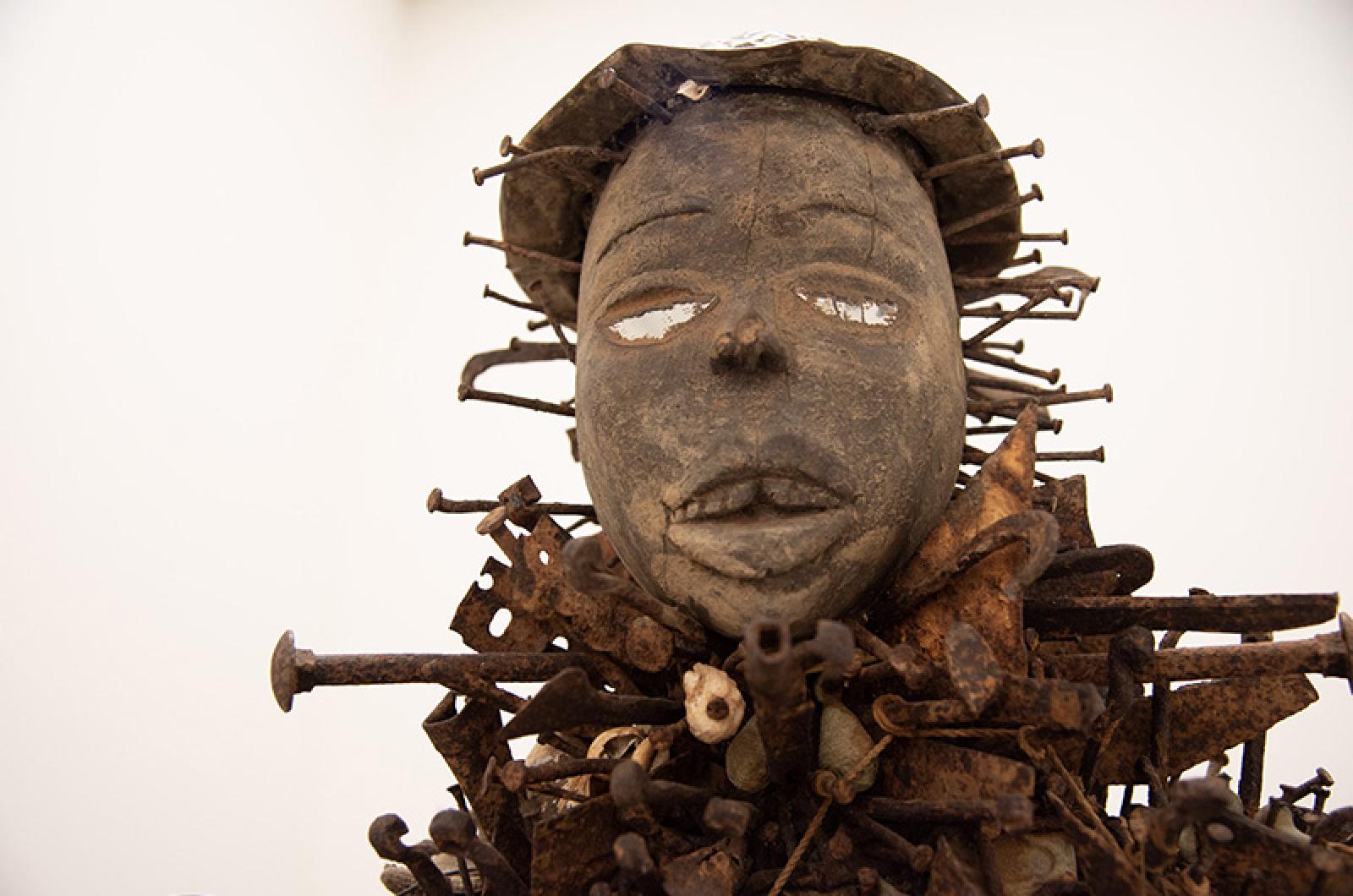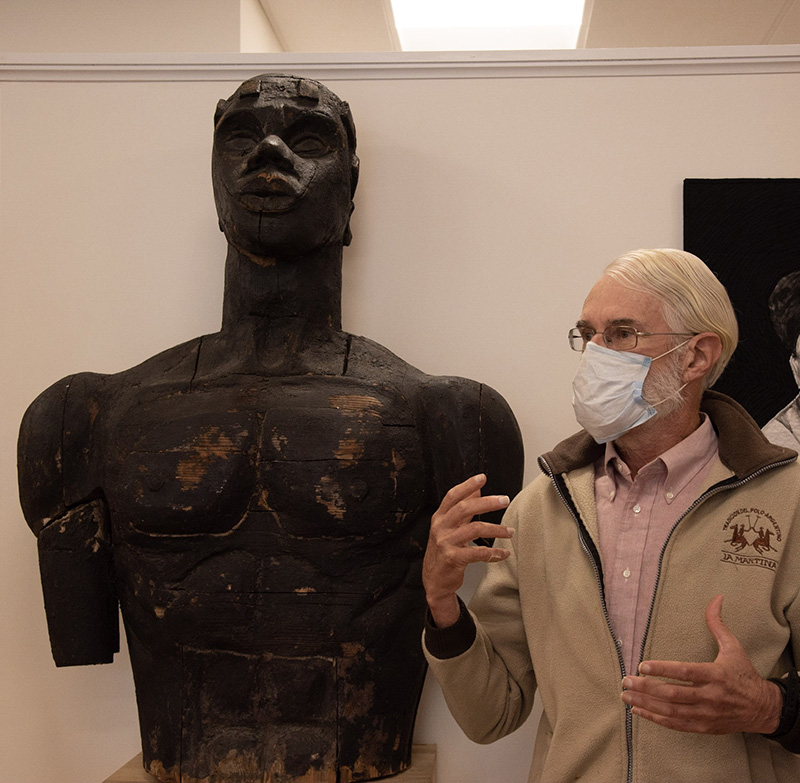Two historic statues — one a monumental, 19th century figurehead made in the West but depicting an African, the other a rare 20th century Nkisi Nkondi statue made in Africa but tied to the West — have been brought together for display at the Mariposa Museum in Oak Bluffs. Curated by prehistorian and Aquinnah resident Duncan Caldwell, the exhibit uses art to form a portal between two worlds that seemingly existed oceans apart, representing the tragic colonial history to which both Africa and the West remain inextricably connected.
“I’m very interested in how African art is similar to art from the western world,” Mr. Caldwell said in a recent interview at the museum. “The [Nkisi Nkondi] is one of the greatest objects to ever be described from the Congo, but it relates back to the West. Just as the [figurehead] relates back to Africa.”
Originally found in upstate New York near the Hudson River and thought by previous museum curators to have been a part of a 19th-century American schooner, Mr. Caldwell said the figurehead on display at the Mariposa is actually a much more rare and mysterious piece.
While it is historically common for figureheads, or wooden decorative carvings found on the bow of ships, to depict a variety of unique images, including women, mermaids, allegories, heroes, deities or even Native Americans, it is exceedingly rare for them to depict Africans. Only three Africanizing figureheads are known in the public record, and the one on display in Oak Bluffs is by far the largest, measuring an imposing 43 inches in height.
“This is monumental in more than one way,” Mr. Caldwell said. “It’s monumental in conception, and monumental in scale.”
Previously overlooked clues on the figurehead, which likely dates to the mid-1800s, hint at its origin. Around its head is a circle of regularly spaced rectangular blocks, each containing traces of yellow paint on their outer surfaces. The yellow paint suggests that the figurehead likely once held a crown, remaking the statue into the image of a king.
Mr. Caldwell thought that because of its enormous size, the figurehead likely was never used on a schooner. But its origin and purpose remains entirely speculative. Mr. Caldwell’s litany of hypotheses range from a slave vessel, to its possible use on a ship liberating freed slaves back to Africa — with the African figurehead representing either a sinister or welcoming totem.
“I think the figurehead is far more fascinating than previously imagined,” Mr. Caldwell said. “It’s a really astonishing piece.”
Just as astonishing is the unique Nkisi Nkondi statue, which Mr. Caldwell has nicknamed “The Magic Trumpeter” because of the trumpet on its right side. Despite being made by the Bakongo people in central Africa in the early 20th century, the trumpeter directly alludes to the United States, Europe, jazz and the horrors of World War I, making it utterly unique, Mr. Caldwell said.
Nkondi statues are central African spiritual statues that have a humanoid base, used by community members who would traditionally drive nails into the statue when making pleas for help. But as the nails and other sharp objects accumulate on the statue, they transform into magical puzzle boxes — an eye-spy of metaphors that map a community’s culture and history. The statue on display in Oak Bluffs has, nestled between its hundreds of nails which emanate outward from the body like the impact of an artillery explosion, numerous objects suggestive of World War I, including the brass facsimile of a military doughboy helmet, wire, multiple grenades, bells and whistles (literally) and the knob from a German trench lantern. But the most striking World War I artifact on the piece is the eponymous trumpet itself, which according to Mr. Caldwell likely came to the Congolese from the famed Harlem Hellfighters, who battled against German soldiers on the Western Front. The Hellfighters spent more time in the frontline trenches and suffered more casualties than any other American unit during the war, also becoming the first unit to reach the Rhine. The bent trumpet on the statue, also known to its musicians as a “casualty,” represents the forced collision between African colonial soldiers and African American ones during the war, both fighting — and dying — on behalf of nations that refused to perceive them as equals.
“The countries ran out of cannon fodder, they ran out of manpower, and they relied on their colonial peoples to provide it,” Mr. Caldwell said. “The heart of darkness wasn’t in fact in the Belgian Congo, where Joseph Conrad thought it was, but it was 100 miles north of Paris where the greatest violence ever created on the planet was taking place.”
The German lantern knob on the trumpeter is contained in a thicket of nails above its mooyo, or center of the piece where it forms the bottom of a hidden cosmogram. Mr. Caldwell thinks the cosmogram’s symbolism harkens back to that notion of darkness — the lantern knob a light shining on the soldiers’ sacrifice.
“The statue represents a hunter for justice,” Mr. Caldwell said. “And at the base of the cosmogram is the regulatory knob for the most efficient lantern used in the First World War. You can imagine how that turns the light, on or off, for the entire cosmos.”
The statues are on display at the Mariposa Museum in Oak Bluffs as part of the Freedom Songs! exhibition through Sept. 30. The museum is closed Monday but otherwise open from 9 a.m. to 6 p.m. Admission is $10.





Comments (2)
Comments
Comment policy »